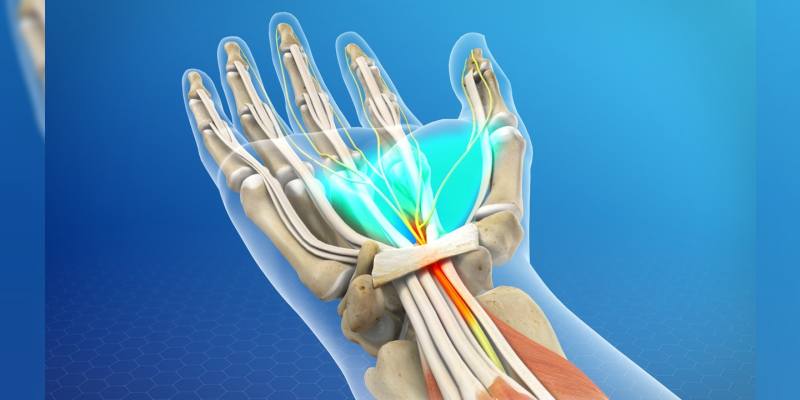Carpal tunnel syndrome is a complex syndrome in which the median nerve is compressed in the waist. The median nerve is located in the palm and it is the only nerve passing through the carpal tunnel. When this nerve is compressed in carpal tunnel, it loses its function. It provides feeling to the thumb, index, middle and ring finger, and control the muscles around the thumb.
In most cases, pain increases at night and radiates to three fingers. It causes burning, numbness and weakness. The reason for this condition is that muscle activity is not available during sleep and circulatory disorder occurs in the median nerve due to laying down.
Carpal tunnel syndrome is mostly in those working with their hands. It is more likely seen in adult women at the age of 40 and above. Those doing home labor, working with computers for a long time, and playing a musical instrument are more likely to have carpal tunnel syndrome.
Symptoms of Carpal Tunnel Syndrome
- Hand and forearm pain increasing by time,
- Numbing in the first three fingers,
- Weak hand muscles,
- Power loss in fingers in advanced stages,
- Electric shock feeling in the fingers.
Causes of Carpal Tunnel Syndrome
Carpal tunnel syndrome is caused by forcing the wrist. Therefore it is seen often with butchers, textile workers, housewives, and those working with computer who are working by bending the wrist. Women and persons above age of 40 are more at risk. Because carpal tunnel syndrome is related to hormones. Similarly, carpal tunnel syndrome is seen in most of pregnant women during pregnancy. Nerve compression occurring due to hormones recovers after pregnancy. Diseases such as diabetes, hypothyroidis, obesity, gout and rheumatoid may cause nerve compression in the wrist.
In Whom the Risk is Higher?
- Professions in which the wrist is forced (Carpet weaver, textile workers, butchers, housewives)
- Those working with a computer for a long time
- Smartphone dependents (Especially those using touch screen phones are at risk of carpal tunnel syndrome.)
- Those sleeping while the hand is under them
- Piano players
- Those playing string instruments
- Women
- Those at the age of 40-60
- Pregnant women
- Those having diseases such as diabetes, thyroid, obesity
Diagnosis of Carpal Tunnel Syndrome
Carpal tunnel syndrome is diagnosed firstly with a physical examination. Hand, wrist, and shoulder are examined in detail. It is checked if there is any swelling, deformation, sensitivity in muscle strength, wrists. Neurotransmission is tested. This test is called EMG.
EMG is performed to measure any nerve or muscle damage with electrical activity. It is the first diagnosis method used in nerve compression diseases. The most common methods used in the EMG test is neurotransmission evaluation and needle EMG. With needle EMG, muscles are examined with needles. With neurotransmission examination, stimulating electrodes are attached to the body. Certain points of the nerves are stimulated. So that, signals in the nerves are revealed. Results are evaluated and information about disease and severity is obtained.
Generally, EMG is sufficient for the diagnosis of carpal tunnel syndrome. However sometimes, ultrasound, which is based on taking images of bones and tissue with soundwaves, MRI and electrophysiology tests can be used.
With the treatment of carpal tunnel syndrome, it is aimed to decrease the pain and paraesthesia, to maintain or increase muscle strength and to maintain hand functions. In the treatment for the first phase, medication treatment and physiotherapy are applied, then surgical treatment is carried out.
Treatment of Carpal Tunnel Syndrome
Treatment methods of carpal tunnel syndrome are divided into two groups. These are conservative and surgical methods. In the first stages of the disease, non-surgical methods are applied. Medication treatment, restriction on wrist movements, resting and various physiotherapy are recommended. If the disease is advanced, the treatment method is surgery. Because, if it is not treated, irrevocable damage can occur in the muscles. For surgical methods, open surgery with standard incision, microsurgery or endoscopic surgery methods is used. The most preferred surgical method is open surgery. Because with this method, median nerve is seen and decompressed. In surgical operations, the tunnel is relaxed, median nerve is released and the patient can go home right after the surgery.
Protection Methods against Carpal Tunnel Syndrome
To prevent carpal tunnel syndrome, daily hand and arm activities are decreased and hand and arm are rested.
By doing wrist and finger exercises, wrist and fingers are not kept in the same position.
When the body is in accordance with body mass index, blood flow and nerves work correctly, the risk of the disease is reduced.
In the case of using a computer, it is essential to keep the wrist in a suitable position and to stretch and bend the wrist and fingers.
In addition, it should be avoided from moving the wrist for a long time and strongly up and down, from holding an object tightly and carrying the excess load.
Blood flow can be increased with regular joggings for 45 minutes, 3 days a week, and it can make a contribution to preventing the disease.








